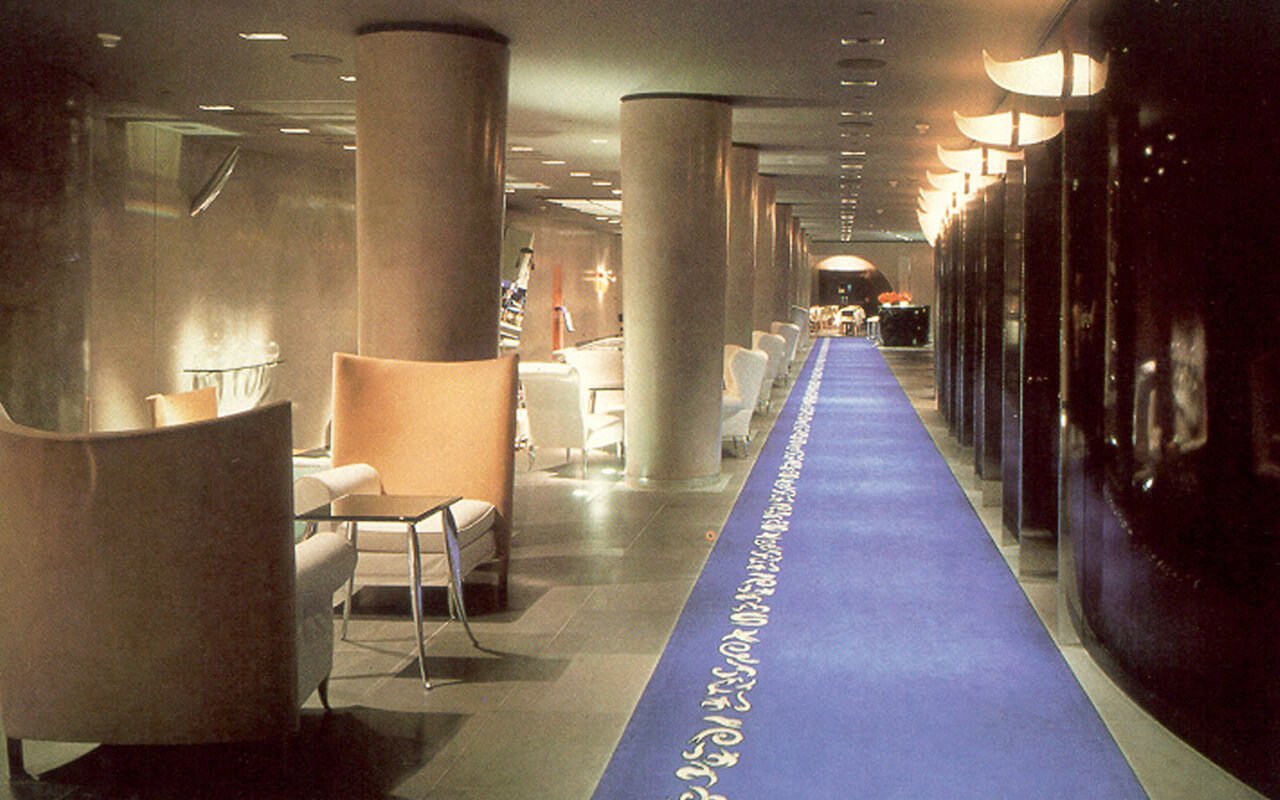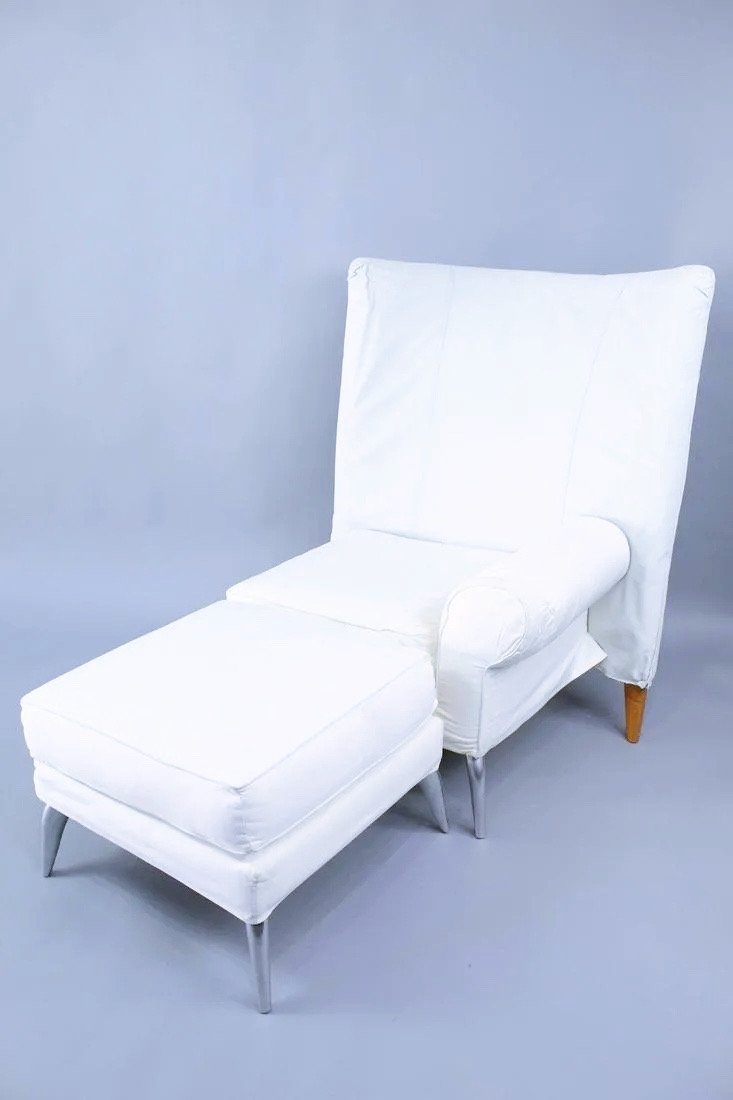Starck’s Royalton Lobby and the Birth of the Designer Hotel
Public Sale’s upcoming auction, Design! Design! Design! features several items designed by late 20th-Century designer Philippe Starck, including a sofa (Lot 007) and chair/ottoman (Lot 006) from Starck’s legendary Royalton Hotel lobby in New York City. The idea of a boutique designer hotel is now a commonplace of the hospitality industry and a widespread cultural phenomenon, influencing everything from the proliferation of art exhibitions and museums designed around selfie moments to the Instagram-friendly interiors of practically every Airbnb with upscale aspirations. But in 1984, when hotelier Ian Schrager asked the then-obscure Philippe Starck to design the Royalton lobby, the notion of a hotel as a designer brand—and its lobby as a destination—was something new.
In 1984 Phillippe Starck was still relatively unknown in the US, though he had attracted attention in his home country of France after designing the interiors of two successful nightclubs. This work would have been known to Ian Schrager, co-founder of NYC’s legendary nightclub Studio 54, who had just opened what many consider the first “boutique hotel,” the Morgans in midtown Manhattan. Starck’s own recounting of how their Royalton commission began is worth quoting in full:
It's 1984, I'm very little. I get an amazing phone call from a guy called Ian Schrager. He said to me, "Can you come to New York? And he sends me a ticket because I did not have a penny. I arrive in New York and he asks me: "Would you know how to make me, reinvent me palaces? I said, "Maybe so, but I'm not hiding from you that I've never been to a palace of my life. He answers, "It does not matter. I have prepared you fifteen days. Every day, twice a day, you will change hotels. And after that, you'll tell me what you think. " That's what I did. he asked me to do the Royalton Hotel. We worked four years because for him it was his first big hotel project. And we gave birth to this thing that did, anyway, a small revolution. That is to say, it was the first time that there was a real act of creation, really personal, really modern, really inventive, but which had the ambition to become a classic. - Starck.com
Starck’s design for the space did some interesting things. Few good photos from that era exist online, but one can get a feeling for the experience that the design created. The corridor of the lobby, which ran the entire length of the city block between 44th and 43rd Streets, was divided into distinct levels, with steps leading down to a sunken seating area, punctuated with dramatic circular columns, around which guests could relax and mingle on Starck-designed furniture. On the opposite side were the reception desk, elevators, and restrooms, backed by a wall of polished teak. This layout transformed the middle section into a kind of elevated catwalk, where passersby could see and be seen, a focal point which Starck adorned with vivid blue carpeting that ran the entire length of the corridor. Architecture critic Fred Bernstein summarized the accomplishment: “Faced with a through-block lobby that, by conventional standards, was too long and too narrow, [Starck] transferred what Schrager had learned about theatrics at Studio 54 to a hotel context—creating the chicest living room in town. Different zones made the narrow space seem wide enough to contain multitudes.”
The results of this commission, which really seems like a collaboration between the hotelier and the designer, were wildly successful, making the lobby into an instant attraction. The hotel’s “44” restaurant became known as “Condé Café” after all the magazine editors who dined there, and at night a parade of stylish revelers helped make the lobby resemble a nightclub—as intended. Starck went on to design Shrager’s Paramount Hotel, and many imitators followed.
Various commentators have described the importance of this moment in the history of the hotel business and interior design. Vicente Wolf, a prominent New York interior designer, called the Royalton “the inspiration for boutique hotels around the world….[it] showed that hotels don’t have to be generic and boring and traditional.” Terry Trucco of Overnight New York called the lobby “a gathering place extraordinaire, a wildly successful template that boutique hotels the world over followed like lemmings.” Architect Calvin Tsao opted for a maritime metaphor, calling the Royalton “the ship that launched 1,000 others.” An article titled “The Invention of the Design Hotel” put it in no uncertain terms: “It is hard to say just how great an impact Ian Schrager’s vision had on our collective idea of what a hotel should be like, but the Royalton in New York and the hotels that followed…definitely changed the hotel market and our approach to travel…Schrager also introduced – fairly successfully – the concept of ‘lobby socializing’, which turned the lobby into a meeting place for both hotel guests and locals.”
For a more in-depth discussion of the Royalton’s impact, see Professor of Design History D.J. Huppatz’s excellent Critical Cities post, which gives context for how Starck’s work “transformed the popular status of industrial design from a technocratic, rational profession to a sexy, cultural one, drawing less upon engineering and systems logic and more upon semiotics and surrealism.” For a sense of what Huppatz is talking about, look no further than the 15 other Starck lots in our auction.
Nineteen years after its debut, the Royalton lobby became a victim of its own success. By then, the culture of boutique hotels was such that the building’s new buyers were almost obligated to put their own stamp on the interior and create a new experience for the next generation of hotel-goers. In a New York Times story from that time, Starck opined that said the new owners should have built their own hotel nearby and seen which one customers preferred, saying “I think if you are lucky enough to own an icon, you shouldn’t kill the icon.” But the legacy of the Royalton lobby lives on. Besides helping to spark the designer hotel trend, it opened up another canvas for the work of designers like Starck. “It proved that you can do something very strong, very personal, and still make it timeless,” he said, suggesting that it helped young designers make their case to clients who may be afraid to commit to strong design statements that could quickly appear dated.
In this way, the designer hotel becomes a tradition that continually renews itself. And as a new design is realized, the pieces of a creation like Starck’s get carted off, sometimes landing at auction houses like Public Sale, and eventually into the interiors of our bidders.



